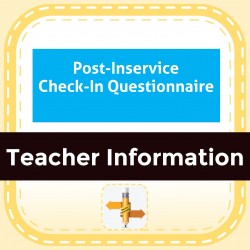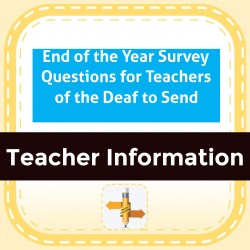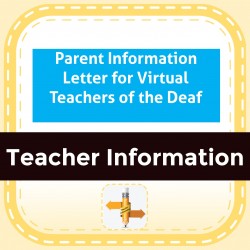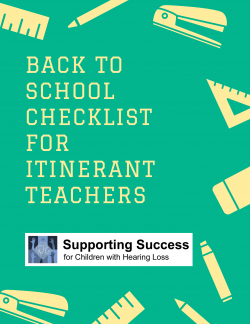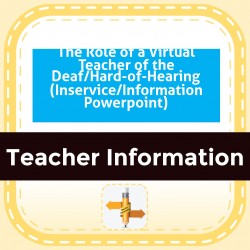Ability Levels
Categories
Resource Types
Age/Grade Range
CCSS
Anchor Standard
Speaking & Listening
Language
Reading
Post-Inservice Check-In Questionnaire (Back to School)
$ 2
Inservice meetings can often been stressful for teachers, especially at the beginning of the school year. Use this resource as a way to check-in with your DHH student's educational team following an i
...
nservice at the beginning of the year. This resource contains a collection of helpful questions to ask your DHH student's educational team after a meeting to see if any more support is needed.You can use the document as it is or you can pick and choose which questions you want to use in an online form.Have a great start to the school year!
End of the Year Survey Questions for Teachers of the Deaf to Send
$ 2
Congratulations on reaching the end of your school year!It's important to reflect on your school year to make sure that you can improve services for next year.This product is a list of survey question
...
s for virtual AND in-person Teachers of the Deaf/Hard-of-Hearing to send to the teachers and staff that work with the deaf/hard-of-hearing students on their caseload at the end of the school year. Pick and choose which questions are applicable to your team, and then add them to a survey/form program.Best of luck to you as you close out your school year!
ITOD - TOD Service Hall Pass: Fillable
$ 3
printabledigitally fillableAre you an itinerant on the run? Are you tired of waiting in the front office for someone to write a pass for your student? Have you had a school(s) ask you to bring your p
...
pass? In the last couple of years, some districts asked all specialists to bring their own prefilled passes, even though we are contracted specialists.Now, when I enter middle and high school, I get looks of relief and often express gratitude for being efficient and professional. **This works best with schools where your identity is already established with front office staff.For those Teachers of the Deaf who do not travel but like pretty teaching things, this might be for you too. This new product costs only $2.00 for a set of 9 designs in fillable or printable options. Plus a page with space to upload your school/agency logo or letterhead.
Parent Information Letter for Virtual Teachers of the Deaf (Printable PDF)
$ 175
Although many families are now familiar with virtual learning, some may not have clarity when it comes to virtual support services. This resource is a letter that can be sent home to families. It expl
...
ains in simple terms the process of working with a virtual Teacher of the Deaf.
IEP Checklist (DHH)
$ 5
All itinerant teachers need to be sure that they have compliant and best practice IEPs. This checklist provides a step-by-step way to review all information necessary for every IEP in a systematic way
...
, from signatures and assessment to Present Ed Levels and Transition and everything in between! This item includes a fillable PDF form, and a Word document that integrates a dropdown feature with suggested answers or assessments. At only $2.00, you deserve this assurance that you are truly complying with all IEP requirements. And it is always a PLUS to be organized!
UDL Service Planning Maps
$ 2
Why Use This?UDL is the Best PracticePrep 1x for your favorite IEP goals - Use Many Times!Easy to tailor your template to your student’s needs.This tool is designed to save you time. Have you gotten
...
otten to the end of an IEP year and realized you forgot one of your most effective, fun lessons? Let’s face it…itinerants & specialists have many activities and resources available to us with TPT. This blessing also means we occasionally forget what is in our proverbial toolbox.How To UseSelect the best calendar for your student’s IEP goal. (August and September starting calendars) Using the “universal design for learning” concept write in your favorite lessons to meet that goal. Adjust the lessons as needed.Do once and reuse for years
Back to School Checklist for Itinerant Teachers - fillable
$ 2
New to itinerant teaching or ready for more organization to the crazy start to the school year? The Back to School Checklist provides a step-by-step checklist to remind you of what is needed for each
...
of your students. It includes a template you can use to create a Teacher Letter for each student. Take this step to getting better organized!
Remote Microphone (Touchscreen) Visual Reminder Printables
$ 150
Who else has students that forget their remote microphones when going from class to class?This product has two different-sized options to print and use for your students who may need a visual reminder
...
to bring their remote microphone with them. There is a full page reminder, and an additional page that has four smaller-sized reminders.The image is of a touch screen remote microphone.
The Role of a Virtual Teacher of the Deaf/Hard-of-Hearing (Inservice/Information Powerpoint)
$ 5
This resource is a Powerpoint presentation that outlines the role of a virtual Teacher of the Deaf/Hard-of-Hearing. The presentation describes the remote learning process, the role of the Teacher of t
...
he Deaf, and some benefits of remote learning. It can be used as an inservice tool or as an introduction to remote learning for school personnel who may not be familiar with working with a remote team member.
Teaching to Our Students Strengths and Needs
$ 195
This article summarizes recent research regarding the language and cognitive differences between students who are DHH and their hearing peers. Identification of these differences can help professional
...
s better understand classroom challenges faced by our students and strategies to support students through these challenges.
 Your browser is out of date. For best experience switch to latest updated Browser.
Your browser is out of date. For best experience switch to latest updated Browser.
 Get Chrome
Get Chrome Get Edge
Get Edge Get Firefox
Get Firefox